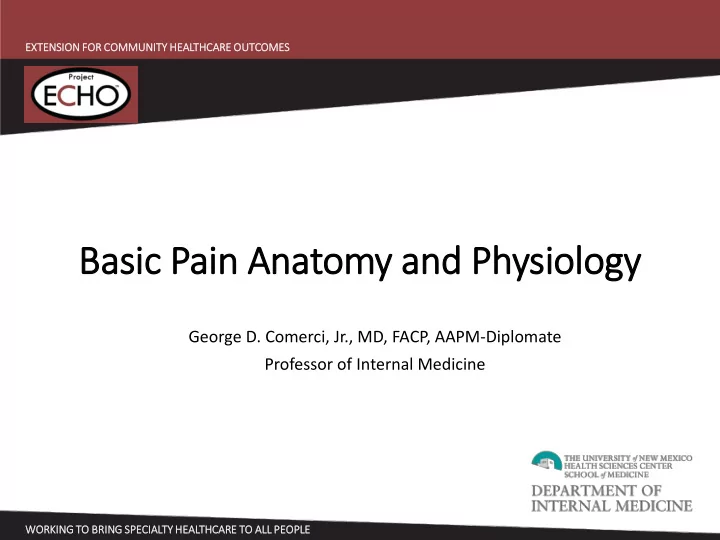

EXTENSION F FOR CO COMMU MMUNITY H HEALTHCA CARE O OUTCOME MES Basic P c Pain A Anatomy and P Physiology gy George D. Comerci, Jr., MD, FACP, AAPM-Diplomate Professor of Internal Medicine WORKING T TO B BRING S SPECIALTY H HEA EALTHC HCARE T E TO A ALL L PEO EOPLE
Obj Object ectives At the end of this session the participant will: 1. Review basic definitions related to the discussion of pain 2. Describe the function of a nociceptor 3. Describe basic pain pathways in the CNS 4. Discuss mechanisms of pain inhibition and facilitation
Basic D Definitions Pain: • an unpleasant sensory and emotional experience associated with actual or potential tissue damage Chronic Pain : • pain that continues beyond the expected time of tissue healing
Basic D Definitions Somatic Pain: • Pain associated with thermal, chemical or mechanical stimuli-(producing tissue damage) Neuropathic Pain: • pain that arises as a direct consequence of damage to the somatosensory nervous system Existential Pain: pain that occurs upon questioning and doubting the value of one’s ongoing existence as a living, sencient being -gc
The N he Noci cice ceptor A transducer…converts one form of energy to another Specialized neuron that responds to mechanical, thermal and/or chemical stimuli
Type pes of S Sens ensory N Neur eurons C fiber: non-myelinated A-delta fiber : lightly myelinated A-beta: thickly myelinated ( light touch/ proprioceptive
Cross Se Sect ction P Perip ripheral N l Nerve (Dept of Physiol. Univ. of Sydney)
http://www.nature.com/nature/journal/v413/n6852/fig_tab/413203a0_F3.html#figure-title The N he Noci cice ceptor r (Nature.2001)
The N he Noci cice ceptor r ( J Clin. Invest.2010)
Noci cice ceptor F r Func unction Stimulus transduction • The receptor (gate) is triggered to open by a noxious stimulus causing sodium to enter the cell and an electrical “spike” to occur Action Potential Generation • The “spike”, if strong enough, causes the nerve to depolarize by means of a flood of sodium entering the cell
Noci cice ceptor F r Func unction Action Potential Propagation: • The wave of sodium entry/depolarization rushes down the length of the neuron towards the presynaptic membrane Transmitter Release • At the presynaptic membrane, the wave of depolarization causes packets of neurotransmitters to be released into the synaptic space
The N he Noci cice ceptor Important neurotransmitters • Calcitonin Gene related peptide • Substance P • Glutamate • Aspartate • Many more…..
The N he Noci cice ceptor r ( J Clin. Invest.2010)
The S he Synapse The junction of the nociceptor with the 2 nd order (spinal) neuron Second order neuron relays information to the supraspinal structures of the brain The synapse of the nociceptor with the spinal neuron occurs in the Laminae of Rexed
Lami minae ae (J Am Acad Ortho Surg.2012)
Pain n Pathways from t the S he Spi pine e to t the he Brain Spinoreticular Tract: spinal neurons that synapse in the Periaqueductal Gray and Nucleus Raphe Magnus- [role in descending pain modulation] Spinal neurons to the medial thalamus-[role in memory and affective components of pain]
Pain n Pathways from t the S he Spi pine e to t the he Brain Spinothalamic Tract: spinal neurons that synapse in the Ventroposterolateral (VPL) thalamus-[role in pain localization-below the head] (Trigeminothalamic Tract): spinal neurons that synapse in the VPL lateral thalamus-[role in pain localization-face and head]
Spi pinal Pathwa ways
The T he Tha halamus Ventroposterolateral (VPL) Nucleus: Synapse with neurons going to somatosensory cortex with the role of localization of pain Medial (Centromedian) Nucleus Synapse with neurons in the limbic system
Spi pinothalamic Pathwa ways
The T he Tha halamus Functions not only as a “switching station” but also has an important role in certain chronic pain conditions Storage of memory recall of the sensory and affective components of pain that is long past • These may be kept “at bay” by inhibitory neurons • Thalamic Syndrome
Pain n and nd the C he Cer erebral C l Cort rtex Somatosensory Cortex Pain Localization Secondary Somatosensory Cortex Anterior Cingulate Cortex Pain Experience Insular Cortex
Modu dulation o n of Noci cice ceptive I e Input nput Endogenous Excitatory Mechanisms • Amplification of nociceptor firing • Amplification of secondary neuron firing (NMDA) • Amplification of descending facilitory neurons
Modu dulation o n of Noci cice ceptive I e Input nput Endogenous Inhibitory Mechanisms Nociceptor • Inhibition of nociceptor firing (NSAIDS, anesthetics/antiepileptic drugs) Spinal • Inhibition of secondary neuron firing (GABA)
Modu dulation o n of Noci cice ceptive I e Input nput Brainstem • Amplification of descending inhibitory neurons from the periaqueductal gray (TCAs/NSRIs) Cortex • Cognitive manipulations (distraction, hypnosis, expectation)
Risk F Fact ctors f for t the development of ch chronic p c pain Gender and Sex Age Efficacy of Endogenous pain modulation Genetics Environmental Factors Psychologic Factors
Summ mmar ary We’ve discussed: Nociception Pain pathways in the CNS Facilitory and Inhibitory Factors
Refer erences es 1. Marchand S. The Physiology of Pain Mechanisms: From the Periphery to the Brain. Rheum Dis Clin N Am. 2008;34: 285-309 Bonica’s Management of Pain. 4 th Ed. 2010.pp24-73 . Walters 2. Kluwer/Lippincott Williams and Wilkins. Philadelphia.
Recommend
More recommend